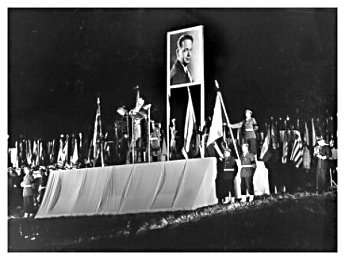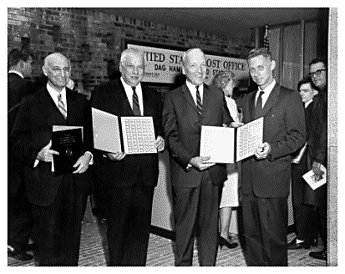|

"His life and his death,
his words and his actions, have done more to shape public expectations
of the office, and indeed of the Organization, than those of any other
man or woman in its history. His wisdom and his modesty, his unimpeachable
integrity and single-minded devotion to duty, have set a standard for all
servants of the international community – and especially, of course, for
his successors – which is simply impossible to live up to. There
can be no better rule of thumb for a Secretary-General, as he approaches
each new challenge or crisis, than to ask himself, 'how would Hammarskjöld
have handled this?'... What is clear is that his core ideas remain highly
relevant in this new international context. The challenge for us is to
see how they can be adapted to take account of it."
Kofi Annan, "Dag Hammarskjöld
and the 21st Century", Uppsala, 6 September 2001
[Full Text]
|
The loss of Dag Hammarskjöld was mourned the world over. At the United
Nations, tributes were paid to his memory (A/PV.1007
[Chinese| French|Russian|Spanish]
and A/PV.1010 [Chinese|French|Russian
|Spanish]). Most famous
among these tributes may be the speech
President Kennedy delivered on 25 September, 1961. Video extract  Audio extract
Audio extract 

A photo of the late Secretary-General looks out over
a crowd gathered
in Stockholm. Literary friend Karl Ragnar Gierow speaks
from the rostrum.
(UN/DPI Photo 72494)
Within a month or so after his death, a number of cities, including
West Berlin, decided to change the names of streets and squares and call
them Dag Hammarskjöld.

At the United Nations, on 16 October, 1961, the General Assembly
adopted resolution 1625 (XVI), entitled, “Memorial to the late Dag Hammarskjöld”
 “The
General Assembly, “The
General Assembly,
Mourning the passing of Mr. Dag Hammarskjöld, Secretary-General
of the United Nations,
Desiring to establish an appropriate memorial commemorating his service
to the United Nations,
Noting with appreciation the hope expressed by the Ford Foundation,
as donor, that the new United Nations Library might be considered in some
measure an appropriate remembrance of Mr. Hammarskjöld’s life,
Decides to dedicate the new library of 16 November 1961 as “The Dag
Hammarskjöld Library”

|
On 16 November 1961, the Dag Hammarskjöld
Library (DHL) was established.

In November 1961, the Nobel Committee of the Norwegian Storting
[Parliament] decided to award the Nobel
Peace Prize for Peace for 1961 posthumously to Dag Hammarskjöld

"in gratitude for all he did, for what he achieved, for what he fought
for: to create peace and goodwill among nations and men."
|
The diploma and medal
were given to Ambassador Rolf Edberg, representing the Hammarskjöld
family.

Shortly after Dag Hammarskjöld's death, the United Nations
Correspondents Association set up the Dag Hammarskjöld
Memorial Scholarship Fund in his honour .
 "We,
the journalists at the United Nations, who saw Dag Hammarskjöld at
his task, and who mourn his death have sought a fitting means by which
we may perpetuate his memory. To this end, we have established a Memorial
Scholarship Fund. It will promote in our profession a wider knowledge of
the United Nations; and it will knit closer ties with the countries whose
independence and advancement were the object of his unceasing labours during
the last years of his life. The Memorial Fund is establishing annual Dag
Hammarskjöld Scholarships for young journalists or students of journalism,
and the first, from Africa, will take up his scholarship this year." "We,
the journalists at the United Nations, who saw Dag Hammarskjöld at
his task, and who mourn his death have sought a fitting means by which
we may perpetuate his memory. To this end, we have established a Memorial
Scholarship Fund. It will promote in our profession a wider knowledge of
the United Nations; and it will knit closer ties with the countries whose
independence and advancement were the object of his unceasing labours during
the last years of his life. The Memorial Fund is establishing annual Dag
Hammarskjöld Scholarships for young journalists or students of journalism,
and the first, from Africa, will take up his scholarship this year."
(Notice posted on the UN Correspondents Bulletin Board,
1961, cited in Dag Hammarskjöld: A Biography, Emery Kelen,
1969)
|
Since the establishment of the Memorial Scholarship Fund, many journalists
from Africa, Asia and Latin America have been brought to New York under
its auspices to observe and report on the United Nations, and also to improve their
professional skills.

1980 Dag Hammarskjöld Fellows of the Memorial Scholarship
Fund
meet New York Mayor Ed Koch, 9 September 1980
(UN/DPI Photo 144510)

The Staff of the United Nations
established a Committee and a Foundation to provide a "living memorial" to
the late Secretary-General. The headquarters of the Foundation were established
in Stockholm.
The Committee invited artist Marc Chagall to contribute a piece of his
work to the memory of Dag Hammarskjöld and to all those who had lost
their lives in the cause of peace. It was decided that the monument would
be a free-standing piece of stained glass. On his first visit to the United Nations Headquarters,
on 15 May 1963, Marc Chagall dedicated the memorial with these words:
"A tous ceux qui ont servi les buts et principes de la Charte
des Nations Unies et pour lesquels Dag Hammarskjöld a donné
sa vie" ["To all who served the Purposes and Principles of the United Nations
Charter, for which Dag Hammarskjöld gave his life".]
|
The panel was unveiled by Secretary-General U Thant on 17 September,
1964. Initially placed in the south-eastern section of the lobby of the
Secretariat Building, facing the East River, the "Chagall Window"
was later moved to the Eastern side of the Public Lobby. (More on the Chagall
Window )

Marc Chagall discusses his art work with Secretary-General
U Thant.
Staff Memorial Committee Paulette Stahl looks on, 11
September 1964.
(UN/DPI Photo 86290)

In Sweden, theDag
Hammarskjöldbiblioteket (Dag Hammarskjöld Library) was founded
by an initiative of the municipality of Uppsala. The purpose was to provide
a lasting memorial to Dag Hammarskjöld and Uppsala was an appropriate
setting for such a library, since Dag Hammarskjöld spent his early
years there.

The Dag Hammarskjöld
Foundation was established in 1962. Its purpose is to organise
seminars, conferences, workshops and consultations on development issues
and to publish and disseminate the results.

Many Member States decided to honour the late Secretary-General
with the issuance of postal stamps.

23 October 1962, the United States issues a stamp honouring
the late Secretary-General. Pictured are (left to right): Mr. J.
Blaustein, Treasurer of the US Committee and member of the Dag Hammarskjöld
Foundation's Board of Directors; Mr. H. Sanborn, designer of the stamp;
Mr. Cordier, President of the US Committee, Dag Hammarskjöld Foundation;
Hon. J. E. Day, US Postmaster General,
(UN/DPI Photo 77322)

On 22 July 1997, on the occasion of the 50th anniversary of
peacekeeping, the Security Council held a meeting
to honour the over 750 000 men and women who served in United Nations peacekeeping
operations. More than 1500 of them lost their lives. At the meeting, by
resolution
1121 (1997), the Security Council established the United
Nations Dag Hammarskjöld Medal as a posthumous award to members
of peacekeeping operations
"as a tribute to the sacrifice of those who have lost their
life as a result of service in peacekeeping operations under the operational
control and authority of the United Nations".
|
On 6 October 1998, the first
Medal was presented to the family of Dag Hammarskjöld. The second
medal honoured Commandant René de Labarrière, Military Observer in United Nations Truce Supervision Organization, who was the first peacekeeper
to lose his life in a United Nations peacekeeping operation, in 1948. The third Medal was received by
the family of Count Folke Bernadotte, United Nations Mediator in Palestine,
who was assassinated on 17 September 1948 in Jerusalem.

Secretary-General Kofi Annan (right) presented the first
Dag Hammarskjöld Medals to families of recipients at a ceremony in
the General Assembly on October 6, 1998.
(UN/DPI Photo 199307C)

Forty years after Dag Hammarskjöld's death, his legacy
is still very much alive. To honour his memory, several commemorative events
are organized.
In July 2001, to mark the 40th anniversary of the death Dag Hammarskjöld, the United Nations System in Zambia, together
with the Government of Zambia, the Swedish Mission in Zambia and the pan-African
Mindolo Ecumenical Foundation (MEF) launched the Dag
Hammarskjöld Living Memorial Initiative to sustain the principles
of peace that the former United Nations Secretary-General fought so hard to uphold.
On September 6, 2001, Secretary-General Kofi Annan delivered a lecture
in Uppsala, Sweden, "Dag Hammarskjöld and the 21st Century". His remarks about Dag Hammarskjöld included the following:
"His life and his death, his words and his actions, have done more
to shape public expectations of the Office, and indeed of the Organization,
than those of any other man or woman in its history. His wisdom and his
modesty, his unimpeachable integrity and single-minded devotion to duty,
have set a standard for all servants of the international community – and
especially, of course, for his successors – which is simply impossible to
live up to. There can be no better rule of thumb for a Secretary-General,
as he approaches each new challenge or crisis, than to ask himself, 'how
would Hammarskjöld have handled this?'... What is clear is that his
core ideas remain highly relevant in this new international context. The
challenge for us is to see how they can be adapted to take account of it.”
On 18 September, 2001, the United
Nations Postal Administration issued three commemorative stamps:
    
and the Dag Hammarskjöld Library launched this special commemorative
website.

On 1 March
2002, the Dag Hammarskjöld Library organized a one day symposium entitled, "The 40th Anniversary
of the Dag Hammarskjöld Library: Legacy of a Secretary-General". This symposium paid tribute to Dag Hammarskjöld, who devoted himself to peace in
the world. It also celebrated the 40th anniversary of the Dag Hammarskjöld
Library, which is a legacy of the late Secretary-General.


This book compiles selected speeches by former Secretary-General Dag Hammarksjöld that focus on the role of the United Nations, the place of the Secretary-General and the nature of the international civil servant. It is issued in commemoration of 50 years since the tragic death in a plane crash of Secretary-General Dag Hammarskjöld in September 1961.
|

